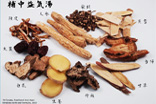
Introduction
The word ‘herb’ usually refers to a medicinal or aromatic plant.[1] In Chinese herbal medicine, however, ‘herbal’ medicines are not only derived from plants, fruits, or trees but also from rocks, shells, and different parts of animals, such as their skin, bones, or organs. Thus ‘herbal’ medicine must be distinguished from purely botanical medicine.
The vast majority of Kampo medicines are botanicals, derived from plant-based herbs that can be found in Europe and in other parts of the world. There is, however, a distinct difference in usage of herbs between Western and Eastern herbalists. Western herbalists operate methodically, and usually consider a single herb for each condition. Examples of these tentative steps include the prescription of Echinacea for colds or peppermint for digestive discomfort. On the other hand, practitioners of Kampo or TCM will often use variety of herbs at one time, in different combinations. These practitioners use a number of classical herbal formulas, typically comprised of anywhere from five to ten different herbs or more, in specific combinations that have been used for thousands of years. The common belief has been that through combining different herbs, both the enhancement of the effects provided by certain herbs can be achieved, as well as neutralizing the negative effects, including toxicity, of others.
The fourteenth edition of the Japanese Pharmacopoeia lists the 165 herbal ingredients that are typically used in Kampo formulas. Approximately half of these ingredients, comprising the standardized Kampo formulas that are in use today, can be traced back to ancient texts.Shang Han Lun(Treatise on Cold Damage) andJinkui Yaolue(Essential Prescriptions of the Golden Coffer) both of which were written in theKanperiod (Han Dynasty, 202 BC –220 A.D.), are vital and still-necessary compilations of this ancient form of medicine.
[1] Winslow LC, Kroll DJ. Herbs as medicines. Archives of internal medicine. 1998 Nov 9;158(20):2192-9.
